Abstract
Conflict between caregivers and infants typically centers on disagreements over the amount and frequency of care provided. Prior research has identified many variables that impact patterns of mother–infant conflict. These include wide-ranging factors such as individual temperament, reproductive status, and availability of resources. By contrast, no studies have investigated the variables that influence father–infant conflict. To better understand the nature of caregiver–infant conflict in a species with obligate biparental care, I observed two groups of San Martin titi monkeys inhabiting disturbed secondary forest fragments in the San Martín region of Peru. Using instantaneous focal sampling of infants, I recorded physical conflict between infants and caregivers and instances of infant avoidance (leaving the infant) by adult males. I summarized data as the percentage of records in which these activities occurred for each focal day and report the estimates for caregivers. I further calculated mean percentages by month of infant age to assess the relative timing of infant conflict, for each group and age/sex class, and infant avoidance by males. Percentages of conflict and avoidance were markedly higher in the larger group living in a smaller habitat than in the other group. This pattern occurred across all age/sex classes. In both groups, the greatest amount of infant conflict occurred with siblings. I discuss the substantial variation in conflict and avoidance in relation to the various socioecological conditions that may have played a role. This study provides an in-depth description and exploration of parent–offspring and sibling conflict, which has not been examined previously in this species.


Similar content being viewed by others
References
Altmann J (1974) Observational study of behavior: sampling methods. Behaviour 49:227–267
Bortolamiol S, Cohen M, Potts K, Pennec F, Rwaburindore P, Kasenene J, Seguya A, Vignaud Q, Krief S (2014) Suitable habitats for Endangered frugivorous mammals: small-scale comparison, regeneration forest and chimpanzee density in Kibale National Park. Uganda PLoS One 9:e102177
Chapman CA, Wasserman MD, Gillespie TR, Speirs ML, Lawes MJ, Saj TL, Zielger TE (2006) Do food availability, parasitism, and stress have synergistic effects on red colobus populations living in forest fragments? Am J Phys Anth 131:525–534
Clutton-Brock TH (1991) The evolution of parental care. Princeton University Press, Princeton
Collinge NE (1987) Weaning variability in semi-free-ranging Japanese macaques (Macaca fuscata). Folia Primatol 48:137–150
DeLuycker AM (2007) The ecology and behavior of the Río Mayo titi monkey (Callicebus oenanthe) in the Alto Mayo, northern Peru. Ph.D. Doctoral thesis. Saint Louis, Washington University
DeLuycker AM (2014) Observations of a daytime birthing event in wild titi monkeys (Callicebus oenanthe): Implications of the male parental role. Primates 55:59–67
Devinney BJ, Berman CM, Rasmussen KLR (2003) Individual differences in response to sibling birth among free-ranging yearling rhesus monkeys (Macaca mulatta) on Cayo Santiago. Behaviour 140:899–924
ESRI (2014) ArcGIS desktop: release 10.2.2. Environmental Systems Research Institute, Redlands
Fairbanks LA (1996) Individual differences in maternal style: causes and consequences for mothers and offspring. In: Rosenblatt JS, Snowdon CT (eds) Parental care: evolution, mechanisms, and adaptive significance. Academic Press, Cambridge, pp 579–611
Fairbanks LA, McGuire MT (1995) Maternal condition and the quality of maternal care in vervet monkeys. Behaviour 132:733–754
Fragaszy DM, Schwarz S, Shimosaka D (1982) Longitudinal observations of care and development of infant titi monkeys (Callicebus moloch). Am J Primatol 2:191–200
Gomendio M (1991) Parent/offspring conflict and maternal investment in rhesus macaques. Anim Behav 42:993–1005
Hauser MD, Fairbanks LA (1988) Mother–offspring conflict in vervet monkeys: variation in response to ecological conditions. Anim Behav 36:802–813
Hayne WD (1949) Calculation of size of home range. J Mammal 30:1–7
Holdridge LR (1967) Life zone ecology. Tropical Science Center, San Jose
Huashuayo-Llamocca R, Heymann EW (2017) Fur-rubbing with Piper leaves in the San Martín titi monkey, Callicebus oenanthe. Figure 1. Location of the study area. Primate Biol 4:127–130. Adapted under a Creative Commons Attribution 3.0 license https://creativecommons.org/licenses/by/3.0/us/
Lawrence JM (2007) Understanding the pair bond in brown titi monkeys (Callicebus brunneus): male and female reproductive interests. Ph.D. Doctoral thesis. New York, Columbia University.
Maestriperi D (2002) Parent–offspring conflict in primates. Int J Primatol 23:923–951
Pavé R, Kowalewski MM, Peker SM, Zunino GE (2010) Preliminary study of mother–offspring conflict in black and gold howler monkeys (Alouatta caraya). Primates 51:221–226
Pavé R, Kowalewski MM, Zunino GE, Giraudo AR (2015) How do demographic and social factors influence parent–offspring conflict? The case of wild black and gold howler monkeys (Alouatta caraya). Am J Primatol 77:911–923
R Development Core Team (2014) R: a language and environment for statistical computing. R Foundation for Statistical Computing Vienna Austria. https://www.R-project.org. Accessed 16 Dec 2018
Rowe N, Myers M (2016) All the world’s primates. Pogonias Press, Charlestown, RI, pp 176–207
Schino G, Troisi A (1998) Mother–infant conflict over behavioral thermoregulation in Japanese macaques. Behav Ecol Sociobiol 43:81–86
Schino G, Speranza L, Troisi A (2001) Early maternal rejection and later social anxiety in juvenile and adult Japanese macaques. Dev Psychobiol 38:186–190
Shanee S, Tello-Alvarado JC, Vermeer J, Bóveda-Penalba AJ (2013) GIS risk assessment and GAP analysis for the Andean titi monkey (Callicebus oenanthe). Primate Conserv 26:17–23
Simpson MJA, Simpson AE, Howe S (1986) Changes in the rhesus mother–infant relationship through the first four months of life. Anim Behav 34:1528–1539
Spence-Aizenberg A, Di Fiore A, Fernandez-Duque E (2016) Social monogamy, male–female relationships, and biparental care in wild titi monkeys (Callicebus discolor). Primates 57:103–112
Trivers RL (1974) Parent–offspring conflict. Am Zool 14:249–264
Veiga L, Bóveda-Penalba A, Vermeer J, Tello-Alvarado JC, Cornejo F (2013) Callicebus oenanthe. The IUCN Red List of Threatened Species 2013: e.T3553A9939083. https://dx.doi.org/10.2305/IUCN.UK.2011-1.RLTS.T3553A9939083.en. Accessed 30 July 2019
Wright PC (1984) Biparental care in Aotus and Callicebus. In: Small MF (ed) Female primates: studies by women primatologists. Alan R Liss, New York, pp 59–75
Wright PC (1985) The costs and benefits of nocturnality for Aotus trivirgatus (the night monkey). Ph.D. Doctoral thesis. New York, The City University of New York
Wright PC (1990) Patterns of paternal care in primates. Int J Primatol 11:89–102
Zhao Q, Tan CL, Pan W (2008) Weaning age, infant care, and behavioral development in Trachypithecus leucocephalus. Int J Primatol 29:583–591
Acknowledgements
I thank the Ministerio de Agricultura y Riego and the Servicio Forestal y de Fauna Silvestre of Peru for research permission and Proyecto Mono Tocón for logistical support and for obtaining research permits. Thanks to Dr. Sharon Gursky for her invaluable guidance in developing and carrying out this research. I am grateful to the two anonymous reviewers and associate editor, Eckhard Heymann, whose contributions strengthened this manuscript. Funding was provided by the Fulbright Program, the Mohamed bin Zayed Species Conservation Fund (Grants 14059810), Primate Conservation Incorporated (Grant 001297), the International Primatological Society, Explorers Club, Sigma Xi (Grant G201503151193669), the L.T. Jordan Foundation, and the Department of Anthropology at Texas A&M University.
Funding
This study was funded by the Fulbright Program, the Mohamed bin Zayed Species Conservation Fund, Primate Conservation Incorporated, the International Primatological Society, Explorers Club, Sigma Xi, and the L.T. Jordan Foundation.
Author information
Authors and Affiliations
Corresponding author
Ethics declarations
Conflict of interest
The author declares there are no conflicts of interest related to this work.
Ethical approval
This research followed the IPS Code of Best Practices for Field Primatology and adhered to all legalities in Peru (Permit #s: N°0208-2012-AG-DGFFS-DGEFFS, N°329-2016-SERFOR-DGGSPFFS).
Additional information
Publisher's Note
Springer Nature remains neutral with regard to jurisdictional claims in published maps and institutional affiliations.
Electronic supplementary material
Below is the link to the electronic supplementary material.
About this article
Cite this article
Hodges, S. Observations of infant conflict and avoidance in San Martin titi monkeys (Plecturocebus oenanthe). Primates 61, 365–371 (2020). https://doi.org/10.1007/s10329-020-00815-4
Received:
Accepted:
Published:
Issue Date:
DOI: https://doi.org/10.1007/s10329-020-00815-4




